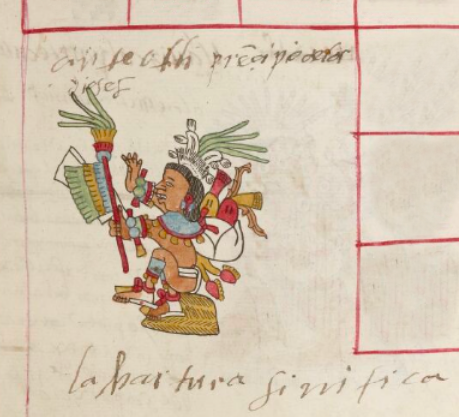Centeotl (TR14r)
This example of the iconography of the divine force or deity Centeotl (also spelled Cinteotl) shows a figure in profile, sitting on a rounded petlatl seat, and facing toward the viewer's left. The white loincloth suggests the male sex. On his back is a white cloth bundle with corn cobs with silk and tassels sticking out, giving away the important association with maize. He has a feathered headdress of what appear to be white heron (aztatl) wing feathers and down balls (probably tlachcayotl), along with green quetzalli feathers. He carries two banners, one white and one decorated with additional feathers of green gold, red, and blue in his left hand. He wears white sandals with red ties at the ankles. He also has leg ornaments and bracelets. His visible eye is open, and his mouth is open, exposing his upper (white) teeth.
Stephanie Wood
Despite the obvious loincloth, the gendering of this figure was somewhat fluid or ambiguous. In Framing the Sacred (2012, 201), Eleanor Wake writes: "Xilonen was the goddess of the young maize ears, who, as the maize ears swelled and ripened, became Chicomecoatl, 'Seven Serpent,' fundamental maize goddess. Chicomecoatl was nevertheless a female aspect of Centeotl (Nicholson 1971: 417). In other explanations of this dual-gendered familial relationship, Centeotl, at once son and grandson of Xochiquetzal is also her husband (Codex Telleriano-Remensis, 22v)."
Centeotl (which appears to build on the word for the dried maize cob, the mazorca in Spanish) might represent the further evolution of the cob as it matures. Eloise Quiñones Keber infers from this relatively lightly decorated figure that "he is a minor figure who represents a deity impersonator of Centeotol or a participant in a ceremony connected with Mayahuel, the missing chief patron of this trecena." But she adds that one of the annotators of the manuscript wrote the Centeotl was the "origin of the gods," who also signifies abundance. [See Codex Telleriano-Remensis, 1995, 174.]
Stephanie Wood
cinteotli
Centeotl (or Cinteotl)
Stephanie Wood
ca. 1550–1563
maize, maíz, mazorcas, deidades, divinidades, fuerzas divinas, cintli, centli, nombres de hombres, feathers, plumas
Cinteo(tl), a name, associated with the Ear-of-maize god, https://nahuatl.wired-humanities.org/content/cinteotl
cin(tli), dried ears of maize or corn, https://nahuatl.wired-humanities.org/content/cintli
teo(tl), divine force(s), https://nahuatl.wired-humanities.org/content/teotl
Telleriano-Remensis Codex, folio 14 recto, MS Mexicain 385, Gallica digital collection, https://gallica.bnf.fr/ark:/12148/btv1b8458267s/f53.item.zoom
The non-commercial reuse of images from the Bibliothèque nationale de France is free as long as the user is in compliance with the legislation in force and provides the citation: “Source gallica.bnf.fr / Bibliothèque nationale de France” or “Source gallica.bnf.fr / BnF.”







